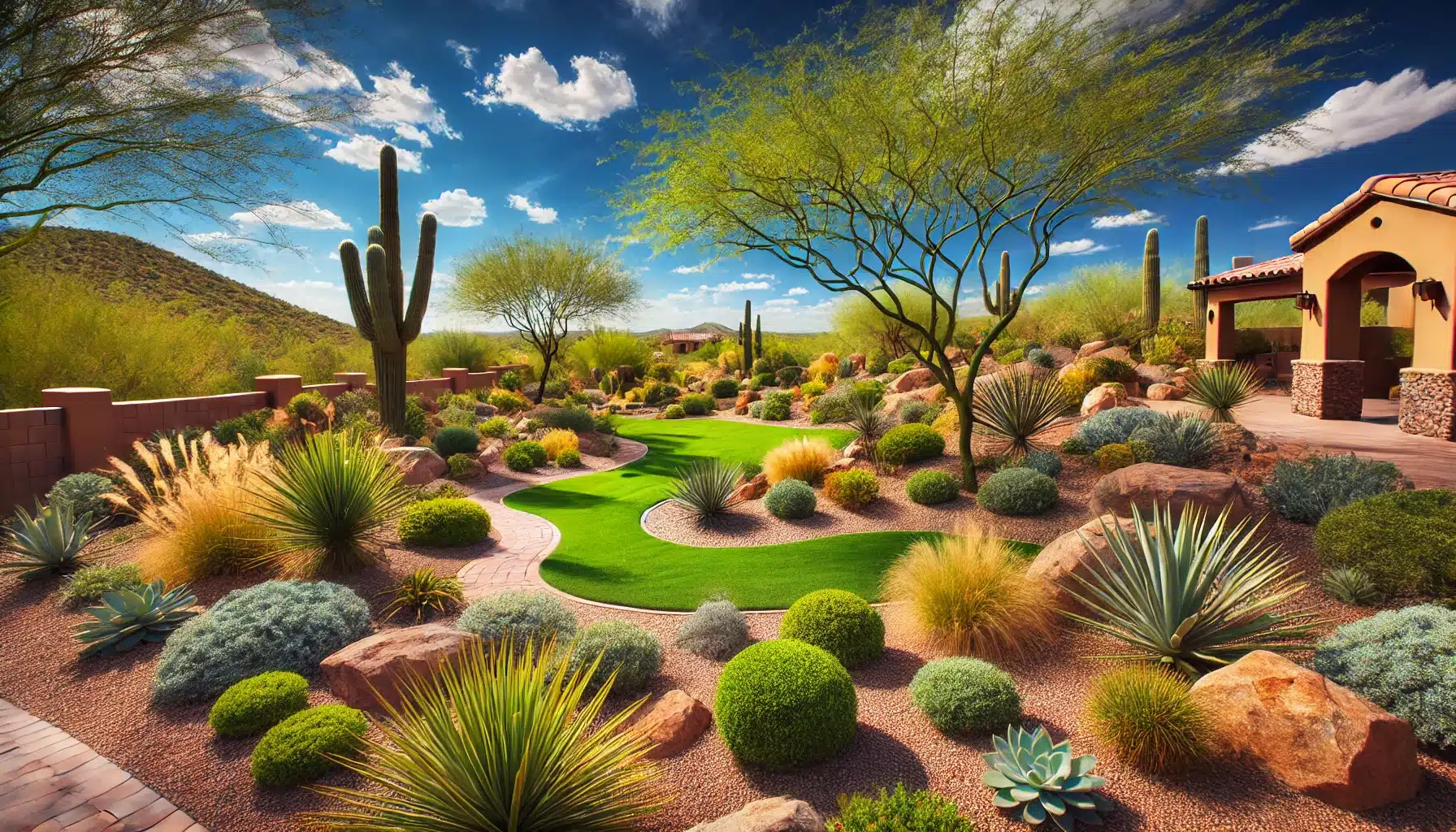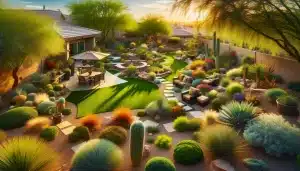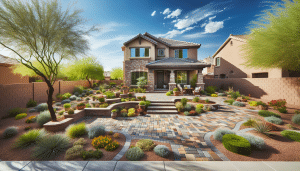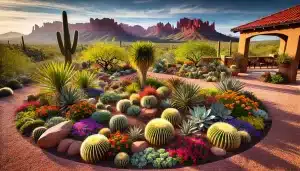Creating a stunning landscape design involves more than just planting a few trees and flowers. There are several underlying factors that significantly impact the overall look and functionality of your outdoor space. At Red Mountain Landscaping, we believe that understanding these elements can help you make more informed decisions and achieve a landscape that not only enhances the beauty of your home but also meets your practical needs. In this blog post, we will explore four crucial factors that you may not have considered in your landscape design process.
Contents
1. Climate and Microclimate
Understanding Your Local Climate
One of the primary factors influencing landscape design is the climate of your area. Arizona, for instance, has a hot desert climate that greatly affects the types of plants that can thrive. When designing a landscape in such a region, it’s essential to select plants that are drought-tolerant and can withstand high temperatures.
Microclimate Considerations
Beyond the general climate, microclimates play a significant role. A microclimate is a localized climate that can differ from the surrounding area due to factors like shade, wind, and proximity to bodies of water. When planning your landscape, consider the following:
- Shaded Areas: These can be cooler and more humid, ideal for plants that require less sunlight.
- Wind Exposure: Windy areas may need windbreaks such as hedges or walls to protect delicate plants.
- Water Sources: Areas near ponds or fountains can be more humid, supporting different plant species than drier parts of your yard.
2. Soil Quality and Composition
The Importance of Soil Testing
Soil quality is a critical factor that many homeowners overlook. The composition of your soil affects drainage, root growth, and the overall health of your plants. Conducting a soil test can provide valuable insights into its pH level, nutrient content, and texture.
Amending Your Soil
Depending on the results of your soil test, you may need to amend your soil to create a more hospitable environment for your plants. Here are some common soil amendments:
- Compost: Adds organic matter to improve soil structure and fertility.
- Sand: Enhances drainage in clay-heavy soils.
- Peat Moss: Helps retain moisture in sandy soils.
3. Water Management
Efficient Irrigation Systems
Water management is particularly crucial in areas like Arizona where water is a precious resource. Installing an efficient irrigation system can ensure that your plants receive the necessary water without wastage. Consider drip irrigation systems, which deliver water directly to the plant roots and minimize evaporation.
Xeriscaping for Water Conservation
Xeriscaping is a landscaping method that reduces or eliminates the need for supplemental water from irrigation. This approach involves:
- Using Native Plants: These plants are adapted to local conditions and require minimal water.
- Mulching: Helps retain soil moisture and reduce weed growth.
- Creating Hydrozones: Grouping plants with similar water needs together to optimize irrigation.
4. Aesthetic and Functional Design
Balancing Beauty and Functionality
A well-designed landscape should be both beautiful and functional. Consider how you plan to use your outdoor space and design accordingly. Here are some ideas:
- Entertainment Areas: Designate spaces for seating, dining, and recreation.
- Pathways and Walkways: Create clear routes for navigating your garden.
- Lighting: Install outdoor lighting to enhance safety and highlight key features of your landscape.
Incorporating Hardscape Elements
Hardscape elements like patios, decks, and retaining walls can add structure and interest to your landscape. When incorporating these elements, think about:
- Materials: Choose materials that complement your home’s architecture and landscape style.
- Placement: Position hardscape features to maximize their functionality and aesthetic appeal.
Practical Tips for Homeowners
Maintenance Considerations
To keep your landscape looking its best, regular maintenance is essential. Here are some tips:
- Pruning and Trimming: Regularly prune trees and shrubs to maintain their shape and health.
- Weeding: Keep your garden beds free of weeds to reduce competition for nutrients and water.
- Fertilizing: Apply fertilizers as needed to ensure your plants receive the necessary nutrients.
Seasonal Adjustments
Adjust your landscape care routine according to the seasons:
- Spring and Fall: Focus on planting and pruning.
- Summer: Ensure adequate watering and protect plants from extreme heat.
- Winter: Prepare your garden for frost and reduce watering needs.
Choosing the Right Plants
Native and Drought-Tolerant Plants
Opt for plants that are native to your region or drought-tolerant species that can withstand the harsh climate. Some excellent choices for Arizona include:
- Cacti and Succulents: Low-water plants that add unique textures and shapes.
- Agave: A versatile plant that thrives in dry conditions.
- Desert Marigold: A bright, cheerful flower that requires minimal water.
Creating a Diverse Plant Palette
Diversity in your plant selection can enhance the visual appeal and ecological balance of your landscape. Consider:
- Color Variety: Mix plants with different bloom colors for a vibrant garden.
- Plant Heights: Combine plants of varying heights to create depth and interest.
- Seasonal Blooms: Choose plants that bloom in different seasons to ensure year-round beauty.
Sustainable Landscaping Practices
Composting and Mulching
Incorporating sustainable practices into your landscaping routine can benefit both your garden and the environment. Composting kitchen scraps and yard waste creates nutrient-rich soil amendments, while mulching helps conserve water and suppress weeds.
Rainwater Harvesting
Collecting and using rainwater for irrigation can significantly reduce your water usage. Install rain barrels or a more elaborate rainwater harvesting system to make the most of natural rainfall.
Reducing Lawn Areas
Traditional lawns require significant water and maintenance. Reducing the size of your lawn and replacing it with native plants or hardscape elements can lower your landscape’s water and upkeep needs.
Conclusion
Understanding these often-overlooked factors can greatly enhance the success of your landscape design. By considering the climate, soil quality, water management, and both aesthetic and functional aspects, you can create a beautiful and sustainable outdoor space. At Red Mountain Landscaping, we are dedicated to helping you achieve your dream landscape.
For personalized advice and professional landscaping services, don’t hesitate to Request a Free Quote. Let us help you transform your yard into a stunning oasis that you can enjoy year-round.




